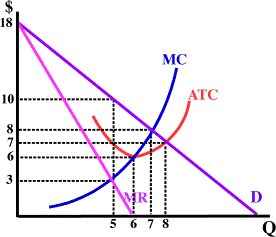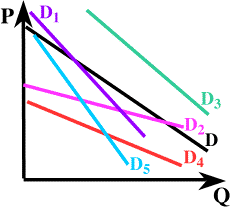Answers to Multiple Choice Questions For Monopoly
Click on the correct answer for detailed help.

- If the monopolist depicted in Figure 1 is maximizing profits, the correct price/output combination will
be:
- Price = 6, Quantity = 6.
- Price = 3, Quantity = 5.
- Price = 10, Quantity = 5.
- Price =7, Quantity = 8.
- Price = 8, Quantity = 7.
- If the monopolist depicted in Figure 1 is maximizing profits, the actual profit earned will be:
- 20.
- 15.
- 35.
- 10.
- 40.
- Remembering that the firm depicted in Figure 1 is a profit maximizing monopolist, in long run equilibrium price
and output will be:
- Price = 6, Quantity = 6.
- Price = 3, Quantity = 5.
- Price = 10, Quantity = 5.
- Price =7, Quantity = 5.
- Price = 8, Quantity = 7.
- Suppose the monopolist depicted in Figure 1 is able to practice 1st degree (perfect) price discrimination if it could do this successfully
the total number of units sold and the price of the last unit
sold will be:
- price of last unit = 6, total quantity sold = 6.
- price of last unit = 3, total quantity sold = 5.
- price of last unit = 10, total quantity sold = 5.
- price of last unit = 7, total quantity sold = 8.
- price of last unit = 8, total quantity sold = 7.
- If the monopolist depicted in Figure 1 is able to practice 1st degree (perfect) price discrimination its total revenue will
be:
- 56.
- 64.
- 91.
- 144.
- 80.
- Suppose a small town in Northern California has only one restaurant.
Suppose the annual earthquake insurance premiums for that restaurant
increase. Which of the following would we expect in the short-run:
- An increase in prices and no change in the number of meals sold.
- An increase in prices and a decrease in the number of meals sold.
- No change in prices and no change in the number of meals sold.
- A decrease in prices and no change in the number of meals sold.
- A decrease in prices and an increase in the number of meals sold.
- Again considering the restaurant whose earthquake insurance premiums
rose, which of the following would we expect in the long-run when
compared with the period just before the insurance premiums rose
(if nothing else changes):
- An increase in prices and no change in the number of meals sold.
- An increase in prices and a decrease in the number of meals sold.
- No change in prices and no change in the number of meals sold.
- A decrease in prices and no change in the number of meals sold.
- A decrease in prices and an increase in the number of meals sold.

Figure 2 - Consider the demand curves shown in Figure 2. If D is the demand curve for a monopolist, which demand curve represents
the one that it will face if a second firm enters the industry.
- D1
- D2
- D3
- D4
- D5
- Again using the demand curves shown in Figure 2, if D is the demand curve for one of two firms in an industry, which
demand curve represents the one that it will face if it is able
to force the other firm to leave the industry by winning a patent
infringement suit against the other firm.
- D1
- D2
- D3
- D4
- D5
- Suppose the diamond industry is a monopoly and suppose that there
is an increase in the productivity of diamond miners. Which of
the following would you predict will happen in the market for
diamonds.
- An increase in the price of diamonds and no change in the number of diamonds sold.
- An increase in the price of diamonds and a decrease in the number of diamonds sold.
- No change in the price of diamonds and no change in the number of diamonds sold.
- A decrease in the price of diamonds and no change in the number of diamonds sold.
- A decrease in the price of diamonds and an increase in the number of diamonds sold.
- Again considering the effect of an increase in the productivity
of diamond miners. Which of the following best describes the profit
experience of the diamond industry as a result.
- an increase in profits from diamond sales because variable costs
fell.
- an increase in profits from diamond sales because the demand for diamond shifted out.
- an increase in profits from diamond sales because fixed costs fell.
- a reduction in profits from diamond sales because variable costs rose.
- a reduction in profits from diamond sales because the demand for diamond shifted back.
- an increase in profits from diamond sales because variable costs
fell.
- Publishing companies typically charge libraries higher subscription
rates than individuals for technical journals. (By technical journals
we mean publications where articles are written by experts in
a field for other experts such as the New England Journal of Medicine or the Molecular Biology or the Journal of Public Economics. It is not uncommon to find that rates charged to libraries are
5 or 10 times or even more above those charged to individuals.
The best explanation for the ability of the firms to do this is
that:
- libraries have more inelastic demands for technical journals that
individuals so the publishers are able to engage in price discrimination.
- individuals need the journals more so the publishers gives them a break.
- libraries have more elastic demands for technical journals that individuals so the publishers are able to engage in price discrimination.
- individuals have more inelastic demands for technical journals so the publishers are able to engage in price discrimination.
- since libraries have unlimited budgets publishers simply take advantage of them.
- libraries have more inelastic demands for technical journals that
individuals so the publishers are able to engage in price discrimination.
- A monopolist's marginal revenue will always be less than market
price. This is because:
- There are substantial startup costs and other barriers to entry.
- The firm is able to practice perfect price discrimination.
- Demand and marginal revenue have an inverse relationship.
- Because monopolist always have higher production costs than other types of firms or industries .
- The monopolist must reduce the price of all units of output, not just an additional unit, in order to increase sales.
- When you go to the movies, the theater is a monopoly vendor of
popcorn while you're there (which is why it costs so much). Suppose
that the cost to the theater of fake butter flavoring and yellow
food coloring rise significantly, what will happen to the price
and quantity of popcorn sold by the theater.
- The price of popcorn will rise and the quantity sold will increase.
- The price of popcorn will rise and the quantity sold will fall.
- The price of popcorn will remain unchanged and the quantity sold will remain unchanged.
- The price of popcorn will fall and the quantity sold will fall.
- The price of popcorn will fall and the quantity sold will increase.
- Due to the increase in the cost of fake butter flavoring and yellow
food coloring the theater will experience:
- an increase in profits from popcorn sales because the demand for popcorn shifted out.
- an increase in profits from popcorn sales because the demand for popcorn shifted back.
- a reduction in profits from popcorn sales because fixed costs rose.
- a reduction in profits from popcorn sales because variable costs
rose.
- a reduction in profits from popcorn sales because the demand for popcorn shifted back.
Table 1 Q P TR 1 20 20 2 19 38 3 18 54 4 17 68 5 16 80 6 15 90 7 14 98 8 13 104 - The data in Table 1 above are for Lane, the only vendor of brick oven baked goat
cheese and avocado pizzas at a sporting event. Q is the number of pizzas sold each hour, P is the price in dollars and TR is the total revenue (just P X Q). If the vendor determines that her profit maximizing price per
pizza is $15 then her marginal cost for each pizza must be:
- over $6 but no more than $8.
- over $8 but no more than $10.
- over $10 but no more than $12.
- over $12 but no more than $14.
- over $14 but no more than $16.
- Suppose at the next sporting event, a few weeks later, we observe
Lane (still with the same monopoly on brick oven baked goat cheese
and avocado pizzas) selling her pizzas for $17 each. If nothing
has changed about the demand data we know then that her new marginal
cost for each pizza must be:
- over $6 but no more than $8.
- over $8 but no more than $10.
- over $10 but no more than $12.
- over $12 but no more than $14.
- over $14 but no more than $15.
© 1995-2004 OnLineTexts.com - All Rights Reserved